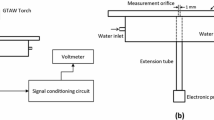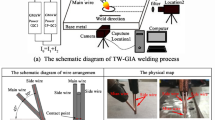Abstract
The aim of this study was to investigate the influence of the discharge parameters on the initial spatial instability of arcs after their initiation by the non-contact method in single-pulse electrode-negative gas tungsten arc welding. The investigated parameters were the Ppeak peak arc pressures, the T durations for achieving the peak arc pressure, and the Pfinal arc pressures at the end of current pulses. It was found that increasing the current amplitudes from 50 to 200 A enhanced mean both the Ppeak values (from 0.25 to 4.00 kPa) and the Pfinal levels (from 0.16 to 1.72 kPa). Enhancing the electrode diameters from 1.0 to 2.4 mm increased these experimental output parameters from 1.85 to 1.99 kPa and from 0.57 to 1.23 kPa, respectively, while they were decreased from 2.32 to 1.47 kPa and from 1.19 to 0.62 kPa after changing the sharpening angle of their tips from 30° to 90°. The period of the spatial instability of arc discharges was shortened from 14.4 to 5.8 ms by increasing the current amplitudes from 50 to 200 A. However, enhancing the electrode diameters from 1.0 to 2.4 mm increased its duration from 9.2 to 12.0 ms. It was also prolonged from 6.2 to 16.8 ms after changing the sharpening angle of the electrode tips from 30° up to 90°. The shortest duration of the arc stabilization period of 5 ms was observed when using the WL15 non-consumable electrode, while it was the longest (35 ms) for the WP one.










Similar content being viewed by others
References
Miyamoto Y, Nishimura T, Fukuhara Y, Koyama Y, Narita K, Sawahisa E (1986) Production of thin wall welded titanium tubes by high frequency pulsed arc welding. Trans Iron Steel Inst Japan 26(5):484–490. https://doi.org/10.2355/isijinternational1966.26.484
Ebrahimzadeh I, Sadeghi B, Maddahi H (2019) Welding of thin sheet of Al5456 aluminum alloy by using GTA and GMA welding process. Mater Res Express 6:066546. https://doi.org/10.1088/2053-1591/ab0d48
Cooper L, Crouvizier M, Edwards S, French R, Gannaway F, Kemp-Russell P, Marin-Reyes H, Mercer I, Rendell-Read A, Viehhauser G, Yeadon W (2020) In situ micro gas tungsten constricted arc welding of ultra-thin walled 2.275 mm outer diameter grade 2 commercially pure titanium tubing. J Instrum 15:06022. https://doi.org/10.1088/1748-0221/15/06/P06022
Meng L, Liang Z, Zhang Q, Yang J (2011) Research and development of high energy pulse precision cold-welding technology. Adv Mater Res 291–294:988–994. https://doi.org/10.4028/www.scientific.net/AMR.291-294.988
de Oliveira Araújo MS, da Silva PCS, de Araújo CJ (2019) Mechanical behavior and fatigue life of micro welded joints obtained by TIG spots in NiTi wires. Smart Mater Struct 28(12):125008. https://doi.org/10.1088/1361-665X/ab4e0f
Połaski P, Jakubowski J (2020) Remanufacturing and surface modification in micro-areas by laser beam and microTIG methods. Weld Technol Rev 92(1):31–43. https://doi.org/10.26628/wtr.v92i1.1092
Correy TB, Atteridge DG, Page RE, Wismer MC (1986) Radiofrequency free arc starting in gas tungsten arc welding. Weld J 12:33–41
Saiepour M, Harry JE (1991) Arc ignition using DC discharges. Int J Electron 70:467–474. https://doi.org/10.1080/00207219108921295
Saiepour M, Harry JE (1991) Characteristics of arcs during non-I contact ignition from cold. J Phys D Appl Phys 24(3):318–324. https://doi.org/10.1088/0022-3727/24/3/013
Shi L, Song Y, Xiao T, Ran G (2012) Physical characteristics of welding arc ignition process. Chin J Mech Eng (Engl Ed) 25:786–791. https://doi.org/10.3901/CJME.2012.04.786
Pang S, Cao B (2021) Low current arc ignition stability in micro-TIG welding. J Manuf Process 69:12–20. https://doi.org/10.1016/j.jmapro.2021.07.022
Černák M, Hoder T, Bonaventura Z (2020) Streamer breakdown: cathode spot formation, Trichel pulses and cathode-sheath instabilities. Plasma Sources Sci Technol 29(1):013001. https://doi.org/10.1088/1361-6595/ab5051
Kristya VI, Supelnyak MI (2011) Influence of the electrode dimensions on its surface temperature in the cathode spot of normal glow discharge. J Surf Investig 5:291–295. https://doi.org/10.1134/S102745101103013X
Puchkaryov VF, Proskurovsky DI (1985) A study of the cathode-spot operation on tungsten point cathodes in the range of threshold arc currents. IEEE Trans Plasma Sci 13(5):257–260. https://doi.org/10.1109/TPS.1985.4316415
Kosovich VA, Lapin IE, Rusol OA (1999) Special features of welding with a low-ampere arc and an ultra-thin electrode. Weld Int 13:571–573. https://doi.org/10.1080/09507119909447415
Park M, Hirata Y, Urabe T (2014) Development of controlled micro-discharge at the atmospheric pressure. Weld World 58:47–54. https://doi.org/10.1007/s40194-013-0092-9
Selyanenkov VN (1980) Methods for experimental determination of the power characteristics of the plasma flow of a welding arc. Autom Weld 10:28–30 ((in Russian))
Lin ML, Eagar TW (1986) Pressures produced by gas tungsten arcs. Metall Trans B 17:601–607. https://doi.org/10.1007/BF02670227
Ham HS, Oh DS, Cho SM (2012) Measurement of arc pressure and shield gas pressure effect on surface of molten pool in TIG welding. Sci Technol Weld Join 17:594–600. https://doi.org/10.1179/1362171812Y.0000000052
de Simas AG, Bittencourt APS, da Cunha TV (2020) Effect of welding variables on GTAW arc stagnation pressure. Weld World 64:1149–1160. https://doi.org/10.1007/s40194-020-00919-x
Savage W, Nippes E, Agusa K (1979) Effect of arc force on defect formation in GTA welding. Weld J 7:212-s-224-s
Burleigh TD, Eagar TW (1983) Measurement of the force exerted by a welding arc. Metall Trans A 14:1223–1224. https://doi.org/10.1007/BF02659870
Adonyi Y, Richardson RW, Baeslack W (1992) Investigation of arc force effects in subsurface GTA welding. Weld J 9:321-s-330-s
Lin ML, Eagar TW (1985) Influence of arc pressure on weld pool geometry. Weld J 6:163-s-169-s
Rokhlin SI, Guu AC (1993) A study of arc force, pool depression, and weld penetration during gas tungsten arc welding. Weld J 8:381-s-390-s
Hiraoka K, Okada A, Inagaki M (1985) Effect of electrode geometry on maximum arc pressure in gas tungsten arc welding. Q J Japan Weld Soc 3(2):246–252. https://doi.org/10.2207/qjjws.3.246
Fan HG, Shi YW (1996) Numerical simulation of the arc pressure in gas tungsten arc welding. J Mater Process Technol 61(3):302–308. https://doi.org/10.1016/0924-0136(95)02190-6
Campbell SW, Galloway AM, McPherson NA (2013) Arc pressure and fluid flow during alternating shielding gases. Part 2: Arc force determination. Sci Technol Weld Join 18:597–602. https://doi.org/10.1179/1362171813Y.0000000141
Dai H, Shen X, Wang H (2018) Study on the arc pressure of TIG welding under the condition of Ar-Ar and Ar-He supply alternately. Results Phys 10:917–922. https://doi.org/10.1016/j.rinp.2018.08.015
Dong Z, Li Y, Wu H, Babkin A, Chang Y (2021) Effect of TIG arc characteristics on weld morphology and structure of AISI444 ferritic stainless steel under pulse current. Weld World 65:2093–2104. https://doi.org/10.1007/s40194-021-01168-2
Sadek AA, Ushio M, Matsuda F (1990) Effect of rare earth metal oxide additions to electrodes. Metall Trans A, Phys Metall Mater Sci 21:3221–3236. https://doi.org/10.1007/BF02647317
Russian State Standard GOST 10157–79 Gaseous and liquid argon. Specifications (in Russian)
ISO 6848:2015 Arc welding and cutting – nonconsumable electrodes – classification
Rossi ML, Ponomarev V, Scotti A (2016) Heat exchange and voltage drop in welding arc column. IEEE Trans Plasma Sci 44:2446–2454. https://doi.org/10.1109/TPS.2016.2606628
da Cruz JR, Scotti A (2016) Materials for thermionically emitting electrodes in arc welding. Weld Int 30:18–26. https://doi.org/10.1080/09507116.2014.932995
Oh DS, Kim YS, Cho SM (2005) Derivation of current density distribution by arc pressure measurement in GTA welding. Sci Technol Weld Joining 10(4):442–446. https://doi.org/10.1179/174329305X44116
Dupont JN, Marder AR (1995) Thermal efficiency of arc welding processes. Weld J 12:406-s-416-s
Author information
Authors and Affiliations
Corresponding author
Ethics declarations
Conflict of interest
The authors declare no competing interests.
Additional information
Publisher's Note
Springer Nature remains neutral with regard to jurisdictional claims in published maps and institutional affiliations.
Recommended for publication by Commission XII-Arc Welding Processes and Production Systems
Rights and permissions
Springer Nature or its licensor (e.g. a society or other partner) holds exclusive rights to this article under a publishing agreement with the author(s) or other rightsholder(s); author self-archiving of the accepted manuscript version of this article is solely governed by the terms of such publishing agreement and applicable law.
About this article
Cite this article
Skripko, S., Gordynets, A., Kiselev, A. et al. Spatial stabilization of arc discharges in pulsed gas tungsten arc welding. Weld World (2024). https://doi.org/10.1007/s40194-024-01781-x
Received:
Accepted:
Published:
DOI: https://doi.org/10.1007/s40194-024-01781-x




